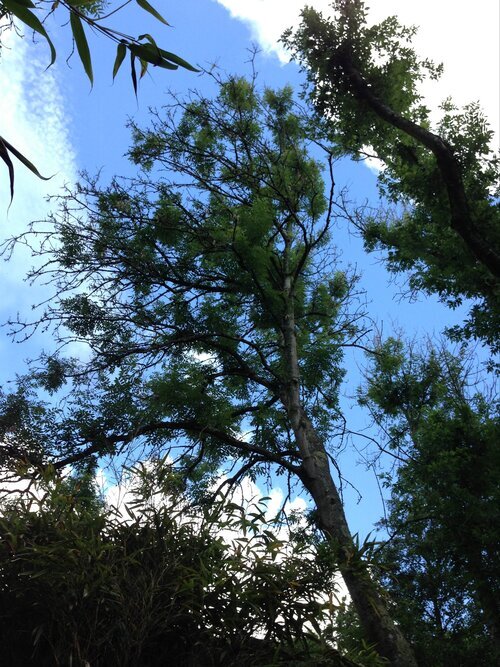What is Ash dieback?
Ash dieback is a highly destructive disease effecting predominantly ash species (Fraxinus), especially the United Kingdom's native Common Ash (Fraxinus excelsior). It is caused by a fungus named Hymenoscyphus fraxineus which is of eastern Asian origin. The fungus that causes ash dieback, also known as Chalara dieback of ash, has spread rapidly across Europe.
The disease affects the trees vascular system causing necrosis in the sapwood that affects the trees ability to draw nutrients up into its upper canopy. The pathogen first inhabits leaves and twigs, in summer residing in the trees leaves and producing spores, which are then rapidly and widely spread around the rest of the tree by rain and wind causing multiple infection sites.
How to identify Ash Dieback?
The first symptoms to indicate that an ash tree might be infected with H. fraxineus is blackening and or wilting of leaves and shoots in mid- to late summer (July to September). These months are the best time of year to survey ash trees for Chalara symptoms in the foliage. This is because once autumn begins in late September or October, the normal seasonal change in the colour of the leaves can be mistaken for symptoms of the disease.
Ash trees that are infected will show signs of foliage loss or foliar death at the top of the crown. Severely affected trees will not bud or flower in spring. Often severely affected trees will produce un characteristic amounts epicormic growth that show the tree struggling for life. We are now seeing evidence of severely affected trees in Kent, given East Kent is believed to be one of the first areas where the infection became evident within the UK in 2012.
The fungus has been noted to cause lesions at the base of infected trees. These lesions, which are not always easy to spot due to a proliferation of basal sucker shoots, will often facilitate colonisation of the tree by secondary pathogens such as Honey fungus (Armillaria spp.), causing the tree to become structurally unstable.
In certain cases these basal lesions have been noted on trees with minimal signs of crown dieback (which is a usual symptom). The photo below shows extensive internal decay following the removal of a roadside ash tree near Canterbury which exhibited minimal signs of canopy dieback. This unseen decay raises potential concerns for tree management contractors instructed to remove defective ash trees, especially where targets exist beneath trees which cannot simply be felled from ground level.
Current Advice for Tree/Woodland Owners
The evidence informing ash dieback policy and the resulting management is under constant review. Whilst there is no evidence of full resistance to the disease, research and experience of the disease in mainland Europe appears to show that approximately 4% of the ash population may be genetically tolerant to ash dieback. This degree of tolerance is exhibited in Fraxinus chinensis which has co-evolved with the pathogen given its elongated exposure. This natural tolerance in some trees provides an opportunity to maintain ash in the UK because the tolerance may be inherited and will create a resistant tree stock to begin to replace the dramatic expected loss of ash trees in the UK. As such the widespread and clear felling of all ash trees without question should be avoided.
If affected trees are situated in high usage areas (e.g. next to roads, footpaths, properties etc) this can create a risk to users of the area, however, this doesn’t necessarily follow that all ash trees growing in these areas will need to be removed or that they will all die.
A programme of monitoring should be undertaken by an experienced and competent arboriculturist during summer when trees are in full leaf to allow the extent of infection to be noted, this should be planned with increased frequency as the trees decline in condition and/or the signs and symptoms of the infection increase.
Trees in areas with high levels of public access need to be managed carefully for risks to public safety and appropriate action must be taken in order to ensure the tree owner remains compliant for their tree related ‘duty of care’.
Advice from the Forestry Commission has been developed through the knowledge of UK researchers and practitioners. It is informed by evidence and experience from continental Europe, where the disease has been established for over 25 years, and from the UK where, more recently, the disease has progressed rapidly in locations such as Kent.
The current Forestry Commission advice recommends that land managers should already be identifying their ash tree population, assessing trees condition, monitoring for any change over time, and be planning mitigation for the expected loss of a large proportion of the species. Such works should look to minimise the loss of ash trees as a habitat used by other species and as an important tree in the landscape by, for example, undertaking compensatory tree planting with site appropriate species in advance of the expected loss of ash trees.
Tree owners, or those tasked with tree management need to prepare their budgetary constraints to not only identify the risks resulting from changes in ash tree condition, but also the management works to bring the tree(s) to a reasonable level of safety. This should include obtaining all necessary consents and approvals for trees on their land so that they can legally fell if they need to. (e.g. Local Authority permissions where trees are located within a Conservation Area or a Tree Preservation Order exists, or felling licence for larger scale tree removal)
The advice is provided in the knowledge that land managers have an overarching duty to comply with the law, and should be acting now in their preparation to deal with the likely increased risks from ash dieback on their ash trees. In particular, their focus must be on ash trees growing within ‘high risk’ locations, like those adjacent to highways, service network infrastructure, buildings, or in areas or routes frequently used by the public.





